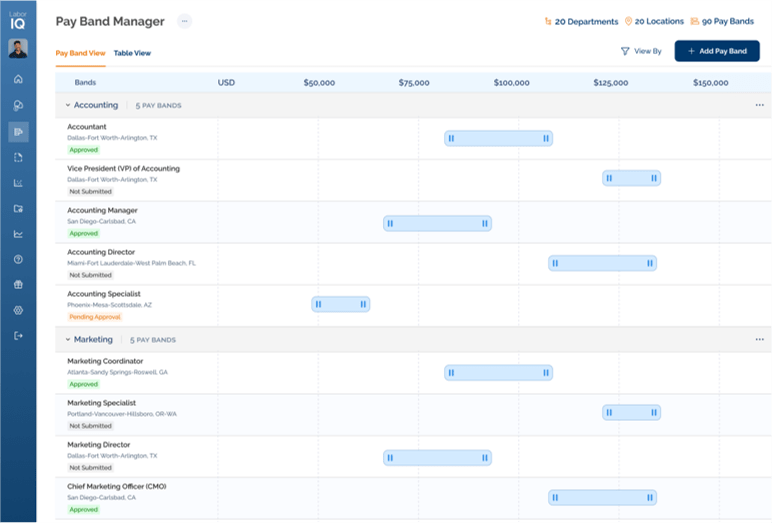Pay bands and pay ranges represent fundamentally different approaches to compensation structure design, each offering distinct advantages for talent management, budget planning, and organizational flexibility. While often used interchangeably, these compensation frameworks require different implementation strategies, management approaches, and administrative capabilities. This article examines the critical distinctions between pay bands and pay ranges, providing HR professionals with strategic guidance for selecting and implementing the optimal compensation structure for their organizational needs.
Defining Pay Bands vs. Pay Ranges
Pay Ranges: Traditional Grade-Based Structure
Pay ranges represent traditional compensation structures that establish specific salary minimums, midpoints, and maximums for individual job grades or positions. Each role typically has a dedicated range with clearly defined boundaries, creating distinct compensation levels across the organization. Pay ranges typically span 40-60% from minimum to maximum, with midpoints anchored to market rates.
Pay Bands: Broad-Based Compensation Framework
Pay bands encompass broader salary spans that cover multiple job levels, functions, or career stages within a single structure. These wider bands, often spanning 100-200% from minimum to maximum, provide greater flexibility for career progression and role evolution without requiring grade changes. Pay bands consolidate traditional pay grades into fewer, more comprehensive categories. In today’s pay transparency requirements, pay band disclosures are required in job postings.
Strategic Implications for HR Departments
Administrative Complexity and Management
Pay ranges require more intensive administrative management due to their granular nature, with organizations typically maintaining 15-25 distinct pay grades. Each range requires individual market benchmarking, regular updates, and specific approval processes for salary adjustments.
Pay bands simplify administration by reducing the number of compensation structures to manage, typically requiring only 5-8 broad bands to cover entire organizations. This consolidation reduces administrative burden while providing greater flexibility for compensation decisions.
Career Progression and Employee Development
Traditional pay ranges often create artificial barriers to career development, requiring formal promotions and grade changes for meaningful salary increases. This structure can limit retention options and create bureaucratic obstacles to recognizing employee growth.
Pay bands enable organic career progression within the same compensation structure, allowing salary increases that reflect expanding responsibilities, skill development, and performance improvements without formal reclassification processes.
Recruiting Strategy Implications
Candidate Attraction and Offer Flexibility
Pay ranges provide clear, specific compensation boundaries that can simplify offer development but may limit negotiation flexibility. Recruiters working within narrow pay ranges may struggle to accommodate exceptional candidates or competitive market pressures.
Pay bands offer superior recruiting flexibility, enabling competitive offers across a broader salary spectrum while maintaining internal equity. This flexibility proves particularly valuable in competitive talent markets where rapid offer adjustments may be necessary to secure top candidates.
Market Positioning and Competitive Response
Organizations using pay ranges must frequently update multiple grade structures to maintain market competitiveness, creating administrative complexity and potential inconsistencies across roles.
Pay bands allow companies to adjust to market shifts more easily, reducing the need for constant structural updates while maintaining salary competitiveness. This flexibility enables more agile competitive positioning and faster response to market pressures.
Retention Strategy Considerations
Recognition and Reward Flexibility
Pay ranges can limit retention options when employees approach range maximums, creating challenges for retaining high performers without promotion opportunities. This constraint often forces organizations into difficult choices between retention and budget discipline.
Pay bands provide extensive retention flexibility through their broader salary spans, enabling meaningful increases for high performers while maintaining structural integrity. This capability proves essential for retaining critical talent in competitive markets.
Performance Management Integration
Traditional pay ranges often struggle to accommodate significant performance differentials within the same role, potentially undermining performance management effectiveness.
Pay bands naturally support performance-based differentiation through their wider spans, enabling substantial salary differences that reflect varying contribution levels while maintaining role consistency.
Budget Setting and Financial Planning
Predictability and Cost Control
Pay ranges provide clear budget boundaries and predictable cost structures, simplifying financial planning and budget development. Finance teams can model costs accurately based on defined grade structures and progression assumptions.
Pay bands require more sophisticated budget modeling due to their flexibility, but offer greater adaptability to changing business needs and market conditions. Organizations must invest in advanced analytics to manage budget implications effectively.
Salary Increase Planning
Range-based structures enable precise salary increase planning through defined progression steps and clear advancement paths. However, this precision can become inflexibility when market conditions change rapidly.
Band-based structures require more strategic salary increase planning but provide superior adaptability to evolving business priorities and market demands.
Implementation Considerations
Technology and System Requirements
Pay ranges integrate easily with traditional HRIS systems and require minimal technological sophistication for effective management. Most legacy systems support range-based compensation administration effectively.
Pay bands benefit from advanced compensation management technology that can handle complex band administration, market analysis, and decision-support capabilities. Organizations should invest in sophisticated platforms to maximize band effectiveness.
Manager Training and Decision-Making
Range-based structures provide clear guidelines that simplify manager decision-making but may limit managerial flexibility in addressing unique circumstances.
Band-based structures require more extensive manager training and decision-making frameworks but enable greater responsiveness to individual employee needs and market dynamics.
Strategic Recommendations
Organizations should select pay bands when prioritizing flexibility, career development, and market responsiveness. Companies operating in dynamic industries or competitive talent markets often benefit from band-based approaches that enable rapid adaptation.
Pay ranges remain optimal for organizations prioritizing administrative simplicity, cost predictability, and traditional career progression models. Regulated industries or organizations with limited compensation management capabilities may prefer range-based structures.
Conclusion
The distinction between pay bands and pay ranges represents a fundamental strategic choice that impacts every aspect of compensation management. HR professionals must carefully evaluate their organizational needs, administrative capabilities, and strategic priorities when selecting between these approaches. While pay bands offer superior flexibility and market responsiveness, pay ranges provide some simplicity and cost predictability. The optimal choice depends on organizational maturity, industry dynamics, and long-term talent management objectives.
Sources for this article include:
- WorldatWork: https://www.worldatwork.org
- Society for Human Resource Management (SHRM): https://www.shrm.org
- HR technology vendors’ best practices documentation
- Professional compensation management publications and journals



















































